ISSN: 2511-7602
Journal for Art Market Studies
ISSN: 2511-7602
Journal for Art Market Studies
Léa Saint-Raymond and Élodie Vaudry
During the colonial conquests, the arrival of African objects on the European continent took place in a situation of asymmetry of military and economic power. To reconstruct the memory of these artifacts, it is essential to consider their circulation paths. While provenance researchers are familiar with looting and “exploration” missions, the commercial circuits are still poorly documented as a whole, due to the lack of account books and archives.
There is a document, however, that allows to consider an aspect of the market for these objects: the minutes of an auction sale, if the transaction took place in the Parisian arena. Thanks to this archive, it becomes possible to pinpoint the seller of each object, its buyer and its hammer price. Matched with the corresponding auction catalogue that gives all the information on the objects, the minutes provide a full picture of all the transactions at Hôtel Drouot. Based on a comprehensive database of all the Parisian auction sales of “primitive” artifacts, and a quantitative and spatial analysis, this paper aims at reconstructing the commercial paths of the African artifacts, in the interwar period. It will identify and map the private and public actors of this market, and cross this information with the origin of the items they sold or bought.
The paths of the African objects were also obscured by the tastes of European collectors. Indeed, our dataset allows us to compare the prices and symbolical value of the African artifacts, with those of the other “primitive” ones. African objects were at the bottom of the scale of preferences in the interwar period and achieved comparatively low hammer prices, with a notable exception: objects from the Royal Palaces of Abomey constituted safe haven values against the background of the 1930s financial crisis.
During the colonial conquests, the arrival of African objects on the European continent took place in a situation of asymmetry of military and economic power. To reconstruct the memory of these artefacts, it is essential to consider their circulation paths. While provenance researchers are familiar with looting and “exploration” missions, the commercial circulation of African artefacts constitutes a nascent but rapidly expanding research field. Thus far, accounts of the African objects’ transition from “ethnographic specimen” to “autonomous work of art” have had to deal with the market dimension of this shift in comparatively haphazard terms: we have much anecdotal evidence and several studies based on individual dealer archives, such as Eugène Boban’s1 (1834–1908), Joseph Brummer’s2 (1883–1947) or Charles Ratton’s3 (1895–1986), but precious little hard data showing in aggregate the exact ways prices and demand changed over time. From a more global point of view, the overall market for African artefacts is still poorly documented.
The auction results analyzed in this article, therefore, help to fill a key lacuna. Indeed, there is a document that allows considering the macroscopic aspect of trade: the minutes of an auction sale – if the transaction took place in the Parisian arena. These records have already shown their usefulness in studying the launch of new auction markets in Paris4 and in analyzing the sales of objects from the looting of the Chinese Summer Palace5 or pre-Columbian arfefacts.6 Thanks to this archive, it becomes possible to pinpoint the seller of each object, its buyer and its hammer price. Matched with the corresponding auction catalogue which gives all the information on the objects, the minutes allow a more comprehensive picture of the transactions. Of course, the Parisian auction scene does not represent the market as a whole, but it does represent the visible tip of a rather more complex iceberg. It is important, in other words, not to regard this particular subset of market transactions as comprehensive. As important as they are as comprehensive, quantitatively-analyzable evidence, the auction minutes are not only a partial representation of the market, but also a “sample” of transactions that is skewed in significant ways. Fortunately, research done by other scholars provides the tools for a partial correction of this bias.7
Based on a comprehensive database of all the Parisian auction sales of “primitive” artefacts in the interwar period8 and on its quantitative and spatial analysis, this paper thus aims at reconstructing the commercial paths of African artefacts sold at auction from 1922 through 1939. It will identify and map the private and public actors of this market, and cross this information with the origin of the items they sold or bought. The Parisian auction market had a dual function. On the one hand, it paved the road for African objects to marketability through concealing the violent context of their initial appropriation and the identity of the majority of the sellers. On the other hand, some active promoters documented these artefacts through exhibitions, photographs and bibliographic references, eventually increasing their commercial and aesthetic value.
The Parisian auction market for African artefacts appeared late, in comparison with other forms of marketing. In the 1900s and 1910s, in Paris, Joseph Brummer and Paul Guillaume sold so-called “negro” objects in their galleries,9 whereas a first auction sale of “nigger sculptures” took place on 12 October 1922 (fig. 1).10 This sale was organized by Paul Guillaume, three years after his “First Exhibition of Negro and Oceanic Art” at the Devambez Gallery.11 He arranged a second auction sale on 25 January 1923, again with Alphonse Bellier as auctioneer and the picture dealer René Keller as expert. For these two events, African objects were sold together with “modern paintings”, and anonymously, since the catalogues did not mention the names of the sellers. On 2 and 3 July 1924, “A lot of 9 woods, black art: a) five masks b) three statuettes c) one club” appeared at auction in Paris, sold by Helena Dmitrievna Delouvina Diakonova (1894–1982), better known as Gala, who had received authorization from her husband, Eugène Grindel, known as Paul Éluard (1895–1952), to sell the collection in order to recover some money. 12 The Éluard sale triggered a shift: not only was a pre-Columbian object put up for sale, joining “Negro art”, but it was also the last time that such objects were marketed jointly with “modern paintings”.
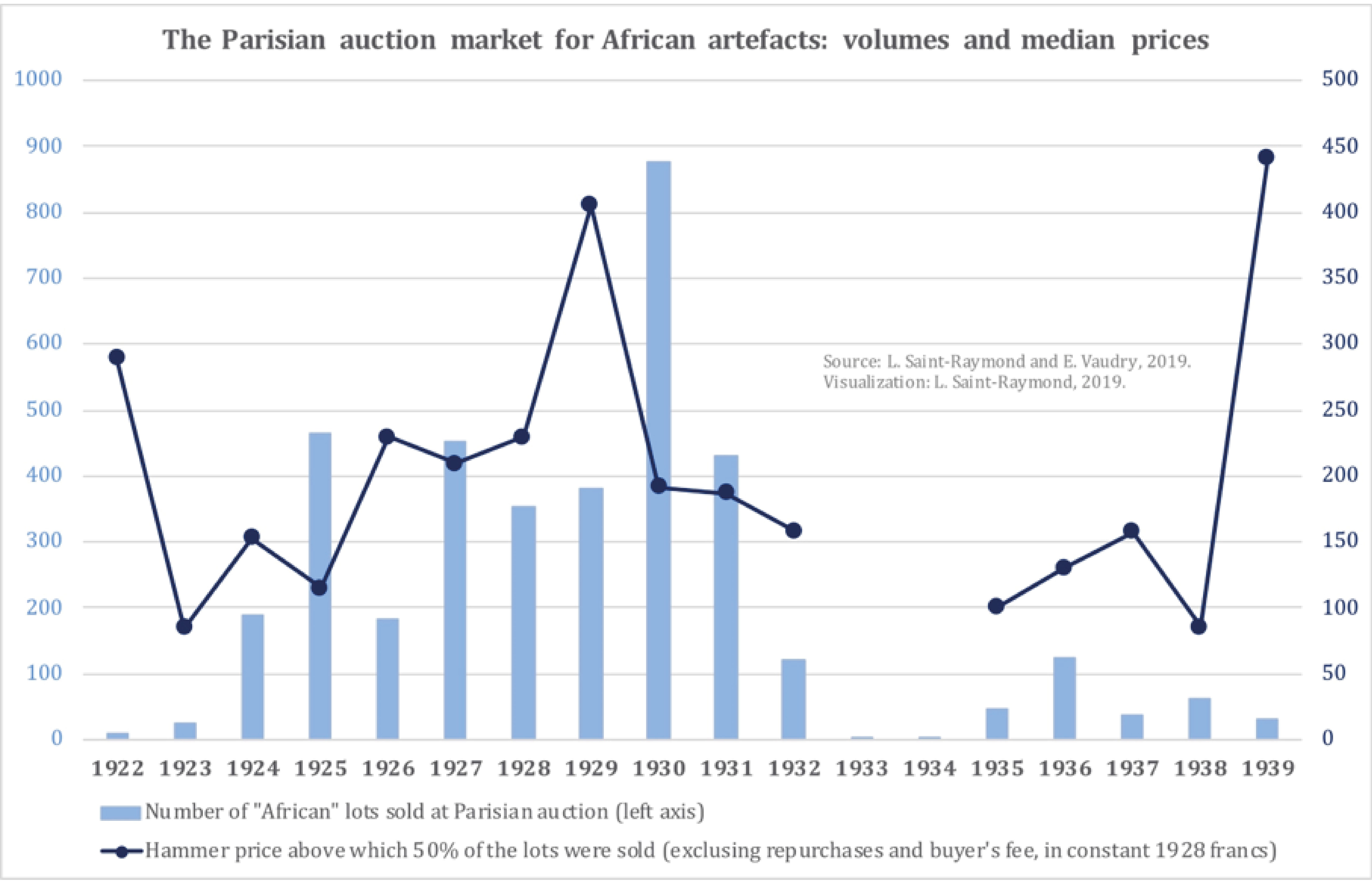
Fig. 1: The Parisian auction market for African artefacts: number of lots and hammer price above which 50% of the lots were sold.
Indeed, on 5 November 1924 the first Parisian auction sale dedicated entirely to so-called “negro art“ (“art nègre”) took place, followed on 19 January 1925 by the first sale dedicated to “primitive art”, as indicated by the titles of the catalogues. From 1924 through 1931, the volume of African artefacts sold at Hôtel Drouot soared (fig. 1), averaging between 200 and 450 lots sold annually, with a peak at 875 lots in 1930. A sharp slowdown followed this boom from 1932 to 1939, with a near disappearance of the African auction market in 1933 and 1934,when there were only two lots a year. The evolution of these volumes is not specific to African objects: pre-Columbian and Oceanian objects show a similar trajectory in the interwar period,13 while Asian objects had a more constant presence, taking the role of a blue chip investment in the 1930s.14 The evolution of hammer prices followed a similar trend. Indeed, the median price, i.e. the price above which 50% of the lots were sold – excluding repurchases and computed in constant francs – witnessed an increase until 1929, followed by a sharp fall from 1930 onwards (fig. 1).
The evolution of both volume and price of African artefacts sold at auction would suggest a speculative bubble, as if these objects had constituted a financial asset deemed an attractive investment which would then have collapsed in parallel with the crash and the subsequent 1930s crisis in France. However, this assumption may seem hasty and incorrect. On the one hand, the auction market for African objects followed the more general economic activity of Parisian sales, as the turnover of Parisian auctioneers dropped in 1930.15 On the other hand, the hammer price of African artefacts was too low, compared to other objects, to really define them as an asset for investment. In 1928, for example, fifty percent of African objects were sold for less than 230 francs – 145 Euros today16 – compared to 720 francs for pre-Columbian artefacts, and respectively 850 and 1,457 francs for Asian and Oceanian ones. African objects overall were at the lower end of the market for non-European artefacts, in financial terms akin to a “junk market”. Nevertheless, in 1939, the exponential increase in the median price raises questions about this assessment: that year, 26 out of 31 African artefacts put on the auction market came from the palace of Behanzin, the former King of Dahomey, in present day Benin and conquered by France in 1894. The auction catalogue states that these lots “were found, buried in the ground at the Behanzin Palace, during the capture of Abomey by the French troops in January 1894”.17 This prestigious provenance increased prices: a “great totemic fetish made of riveted silver plates” representing an elephant achieved the highest hammer price of 2,100 current francs excluding buyer’s premium, i.e. 1,611 constant 1928 francs and 1,015 euros today.18
The rise in prices for modern-day Benin artefacts is based on their layered history and the memory they conveyed in comparison to other, relatively ahistorical African objects. Their origin also served to justify their commercial and aesthetic value. Indeed, scholars and art professionals agreed in their appreciation of Benin’s production because of their sculptural quality and their supposed European influence. Some Dahomean objects were acknowledged to be of extraordinary aesthetic merit from the very beginning of the French interest in “art nègre”, such as the iron statue of Gou in the Trocadéro collection that Apollinaire singled out for praise as early as 1912, yet many others were of a style that modernist connoisseurs of the 1910s and 1920s would have considered unappealingly naturalistic.19 In the French context until the later 1920s, the market value of Dahomean objects probably stemmed more from their status as patriotic memorabilia, as the Second Franco-Dahomean War of 1892-94 had been extensively publicized in the French popular press, which was full of lurid stories of féticheurs, human sacrifice, and “amazons.”20 Among the “junk” market of African artefacts, some lots could thus be considered as blue chip assets. It is thus necessary to open the black box of this global category and to link their value creation with their provenance.
The quantitative tools allow us to take a step back from the 3,910 African lots sold at auction in Paris between 1922 and 1939. The following map (fig. 2) matches the geographical origin of the African artefacts as indicated in the catalogues with the colonial division of Africa during the interwar period. The link between the Paris auction market and the French colonial empire is evident: 2,599 African lots were sold in Paris, of which two thirds came from French colonial regions, first and foremost French Equatorial Africa (AEF) with 1,296 lots from “Congo”. French West Africa (AOF) provided 446 lots from the Ivory Coast, 283 from modern-day Benin and 126 lots from French Guinea. Belgian Congo supplied 451 lots, or 11.5% of the volume, followed by Great Britain with 249 lots, or 7%, mainly from Sudan, and finally Portugal with 78 lots (fig. 2). In these calculations, 13% of lots are omitted since the catalogues did not mention precise geographical origin for this section other than their continent, Africa. As such, 13% of lots sold at auction in the inter-war period in Paris in this category were of unspecified origin.
Anonymity also characterized most of the sellers. Of forty-three sale catalogues featuring African objects, only seven clearly indicated the name of the seller—Paul Éluard, for the sale on 5 November 1924, Walter Bondy (9–11 May 1928), Paul Rupalley for two sales, in March and June 1930, André Breton and Paul Éluard (2–3 July 1931), Ruyters (16–17 May 1938) and George de Miré (16 December 1931). Four other catalogues simply mention seller’s initials, whose identity is revealed by the minutes: the sale of “B. C.” of 5 November 1924 corresponds to Boffard-Coquat, “G. A.” on 19 and 20 November 1928, to Georges Aubry, and “F. B. H.”, 22 June 1936, to Frank Burty Haviland; while in the absence of the minute of the 27–28 June 1935 sale, it is difficult to identify the seller “M. V.”. Three-quarters of the sale catalogues were therefore completely anonymous and did not mention either names or initials of the sellers. Most of them were “ventes composées” or mixed consignor sales, grouping items from several sellers. The minutes, where available, usually list them (fig. 3), attributing a number to each seller which will be listed when their items are put up for sale, together with the hammer price and the purchaser’s name. In this example, the minutes (fig. 3) assign number 2 to a certain “Monsieur Breton” living at 42 rue Fontaine and number 12 to “Monsieur Fénéon” living at 15 rue Eugène Carrière, in Paris.
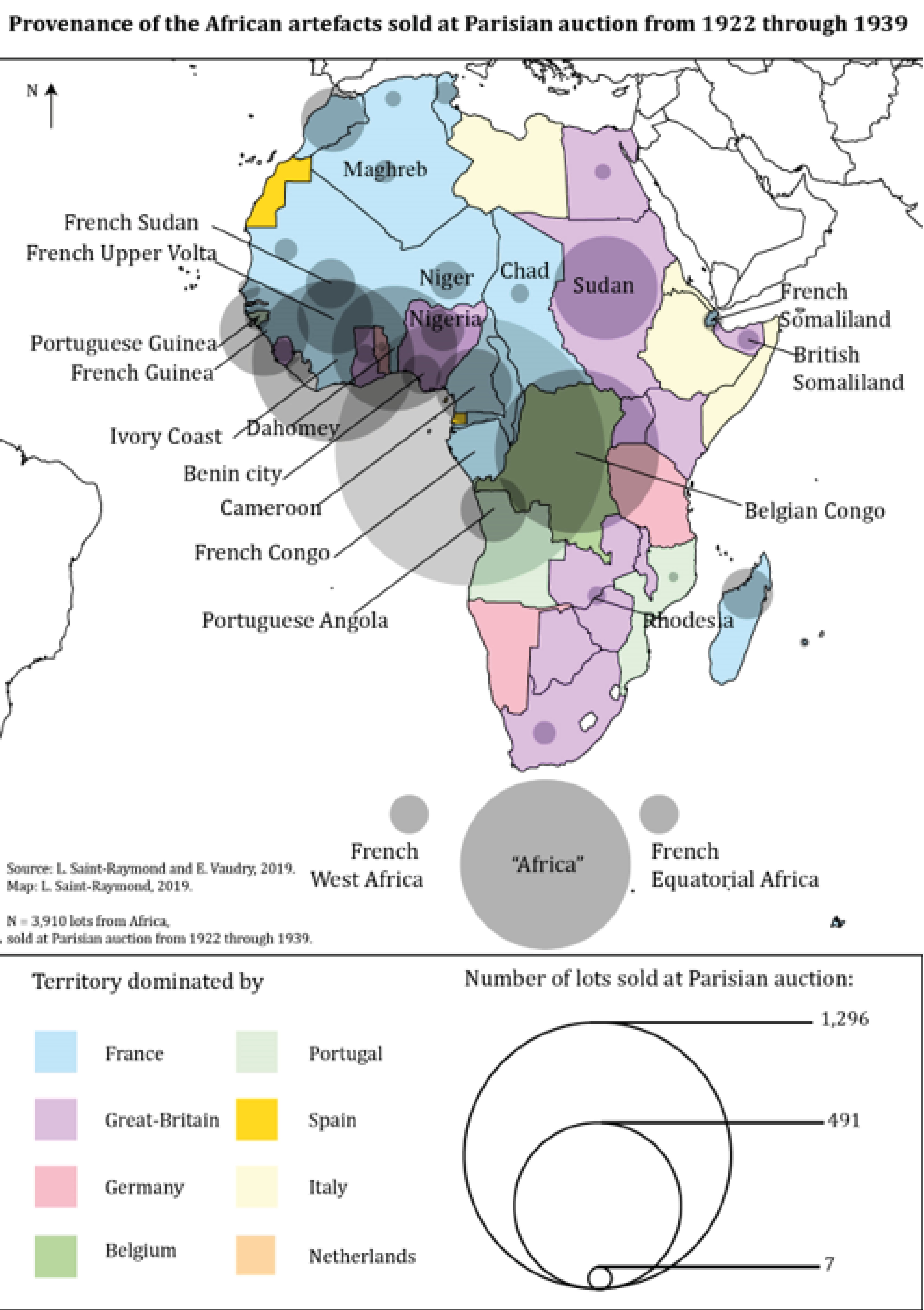
Fig. 2: Provenance of the African Artefacts sold at Parisian auction from 1922 through 1939
To trace and understand the commercial circulation of African objects, the minutes provide three clues: the seller’s last name and sex (“Monsieur”, “Madame”/“Mademoiselle”), and his or her address. In the interwar period, 137 different sellers consigned one or more African objects to Parisian auction: 130 resided in metropolitan France – 86 of them in Paris, that is two thirds. Of the last seven sellers, four gave an address in Berlin – Walter Bondy, Fritz Gurlitt, Kurt Mengers and S. Stossinger; two lived in Brussels – Henri Lavachery and Mr. Suaris – and the last, Kickles Henchir el Asiat, in Beja, Tunisia. However, when looking at the volume of items that these sellers consigned for sale (fig. 4), these six Belgian and German sellers supplied the market massively, up to 13% of the total volume. Another map (fig. 4) also shows the importance of sellers “de province” (living in France, but not in Paris), who provided 31% of the total number of African lots at Parisian auction.
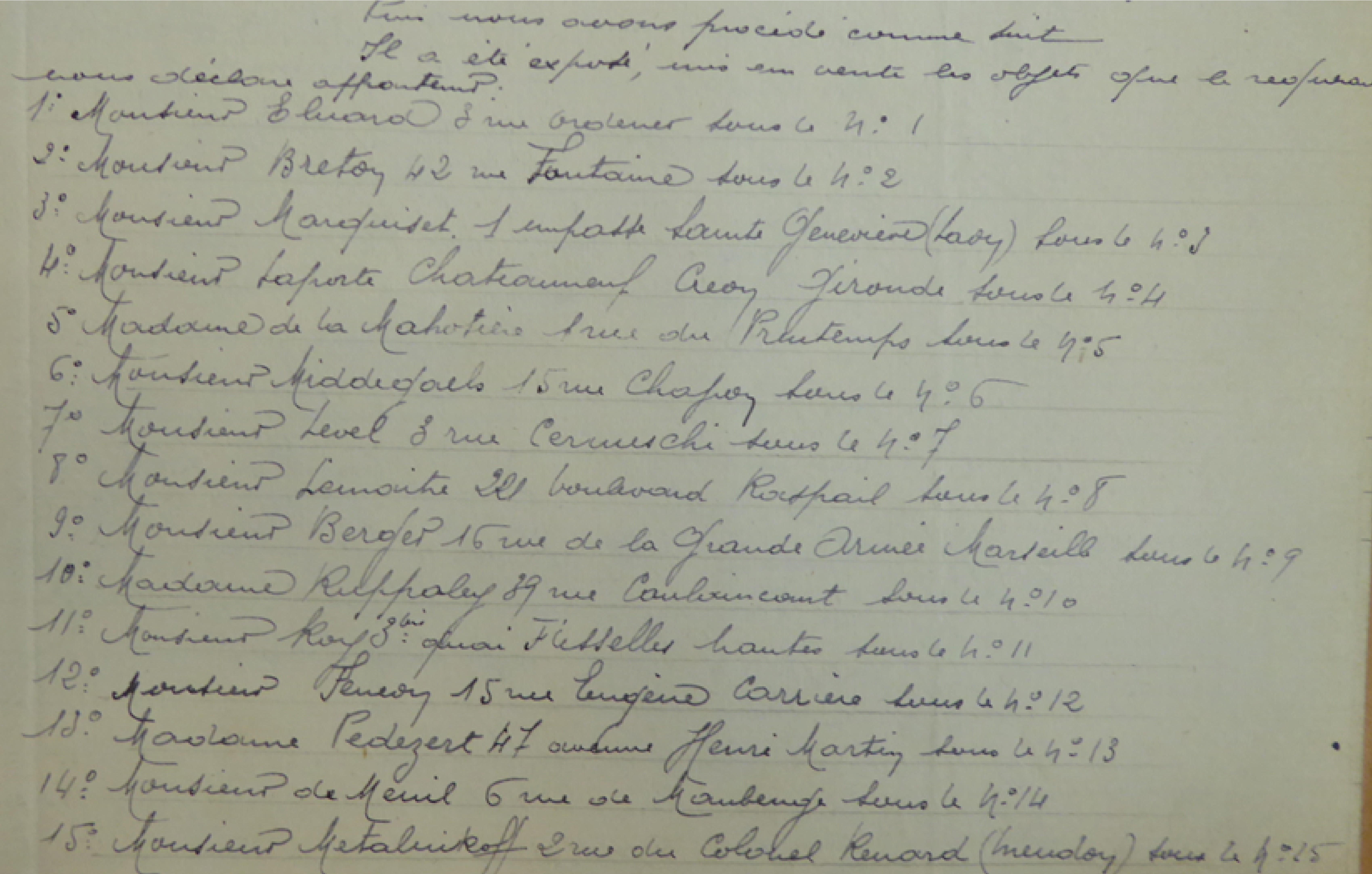
Fig.3: List of sellers mentioned in the minute of the 19 and 20 May 1927 auction sale. Archives de Paris, D141E3 15.
Unfortunately, the minutes of the sales did not mention the occupation of the sellers. However, it is possible to find the identity of the seller in the available address books and directories, along with civil status and census registers. If, in our last example (fig. 3), André Breton (1896–1966) and Félix Fénéon (1861–1944) are easily recognizable, many sellers are harder to identify, especially when they did not live in Paris. For example, it was impossible to identify the seller no. 4 (fig. 3), Mr. Laporte who resided in the Gironde region at the castle of Créon.21 The following graph (fig. 5) lists the main sellers of African artefacts by volume of lots. Three men sold more than 200 lots each: the Berliner Kurt Mengers, about whom no further information is known, Mr. Laporte and Paul Rupalley. Then followed, with 180 lots, Éléonore Marguerite Boffard-Coquat, almost certainly the widow of Ernest Antoine Laurent Boffard Coquat (1852–1916), military and inspector of posts and stations, in Senegal, Gabon and Congo, who had explored the course of the Ogooué river.22 The collector and art critic Félix Fénéon is the fifth largest seller by volume, with 152 lots, followed by the businessman and collector André Level (1863–1947) with 120 lots and Albert Middegaels (1846–1923) or rather his son, the owner of the Parisian shop À l’éléphant blanc, 32 bis boulevard Haussmann, specializing in ivory objects.23
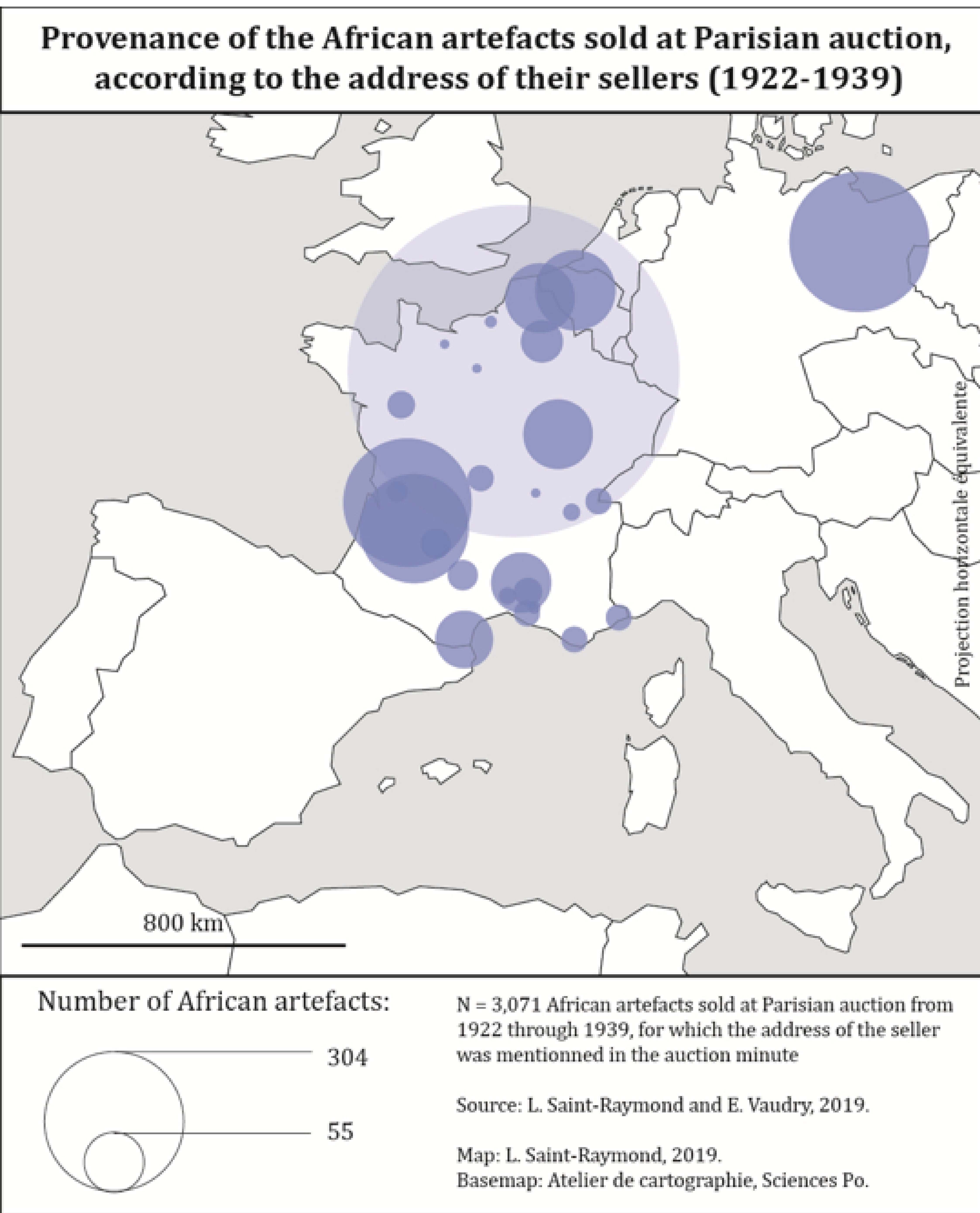
Fig. 4. Provenance of the African artefacts sold at Parisian auction, according to the address of their sellers (1922-1939).
Noticeably, the people who consigned objects for auction sale in Paris in this period were generally not “coloniaux” (fig. 5). In addition to Marguerite Boffard-Coquat, the explorer’s widow, it is possible to identify, not without some element of uncertainty, the presence of Jean Dybowski (1856–1928), who was Inspector General of Agriculture in the colonies, particularly in Africa,24 and the colonial administrators Charles Marchal (1855–1917), Governor of Dahomey in 1902 and from 1906 to 1908, and Lucien Geay, who occupied the same position in 1928.25 Finally, it is likely that “Reverend Father Kientzmoun”, about whom no other information is available, was a missionary. These few sellers with documented colonial connections – Boffard-Coquat, Dybowski, Marchal – came from the elite of the colonial milieu, well above lower-level administrators, soldiers, or businessmen. From the small number of sellers whose occupation was linked to colonization, it is possible to draw an obvious conclusion: most of the African objects sold at Hôtel Drouot did not come directly – and thus by force – from the African continent, but had already undergone previous transactions. The presence of dealers among the main sellers confirms this assessment (fig. 5): Middegaels, the antique dealer Charles Vignier, who appears in the Bottin du commerce as a seller of “chinoiseries and japoneries”, Paul Guillaume, and André Portier, who was a Parisian auction expert and also a dealer of non-European, predominantly Asian objects.
The following graph (fig. 6) shows the sellers of artefacts from the pre-colonial kingdom of Dahomey, that is a category of African objects most obviously with a provenance relating to war booty or colonial seizure. The distance between the auction market and the colonial seizure is even more striking here. Indeed, very few sellers can be identified as coming, most probably, from the colonies: Mrs. Boffard-Coquat, Jean Dybowski, the governors of Dahomey Charles Marchal, Lucien Geay and Victor Ballot (1853–1939), who was the first to hold this position between 1894 and 1900, and the possible heirs of Amédée William Merleau-Ponty (1866–1915), governor of the AOF in 1907 and from 1908 to 1915.26 While it is possible to recognize some famous collectors and Parisian sellers (André Portier, Stora, the antique dealer Georges Aubry and the Japanese print and Chinese art dealer Ernest Le Véel), many consignors remain unknown. Moreover, it is impossible to assign a seller to 19% of the lots consisting of artefacts from the pre-colonial kingdoms of Dahomey and Benin (in present-day Nigeria, conquered by Britain in 1897) (fig. 6), either because the minutes are missing or because the seller’s number is not mentioned, which obscures the record.
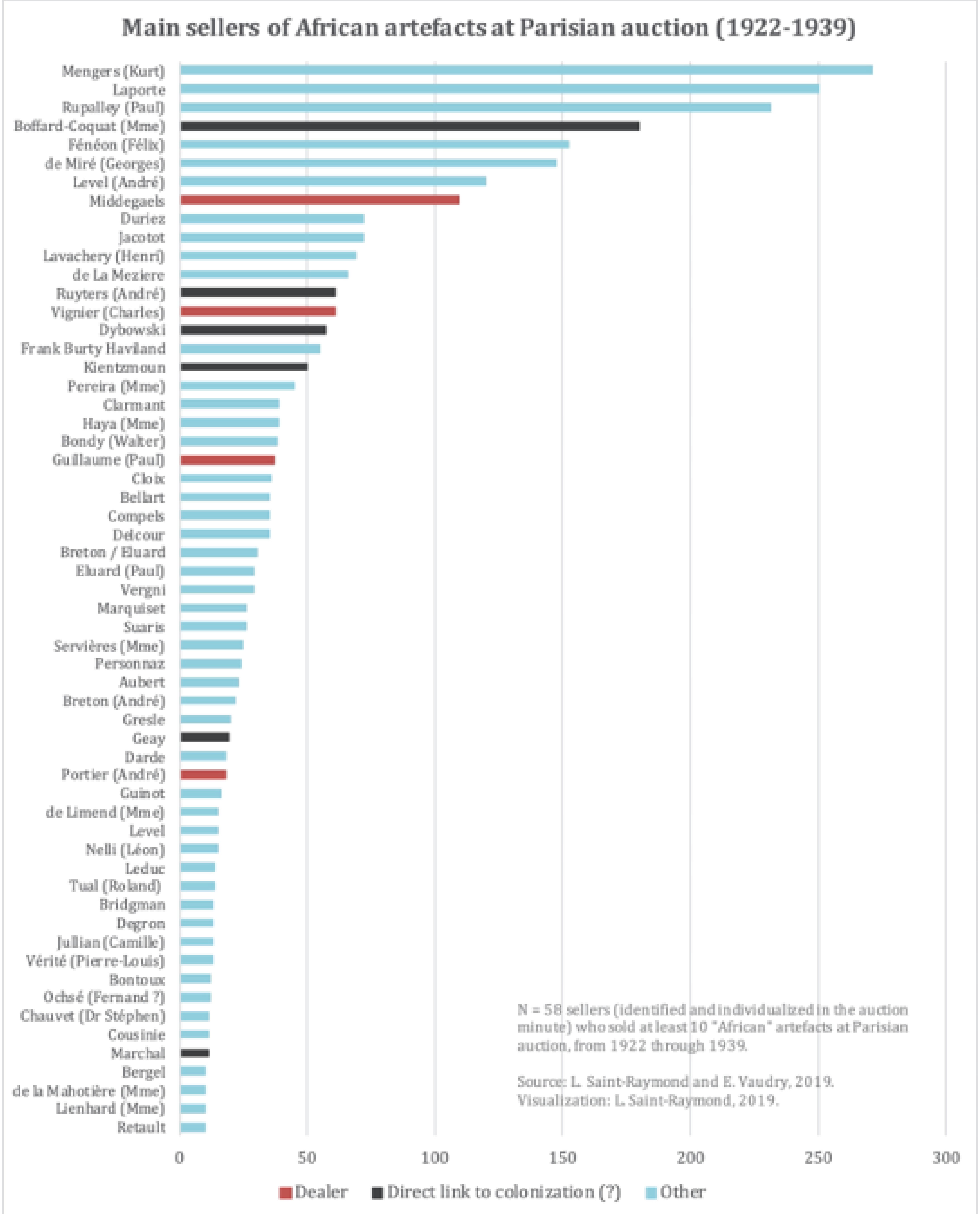
Fig. 5: Main sellers of African artefacts at Parisian auction (1922-1939), sorted by the total number of lots they put on the auction market.
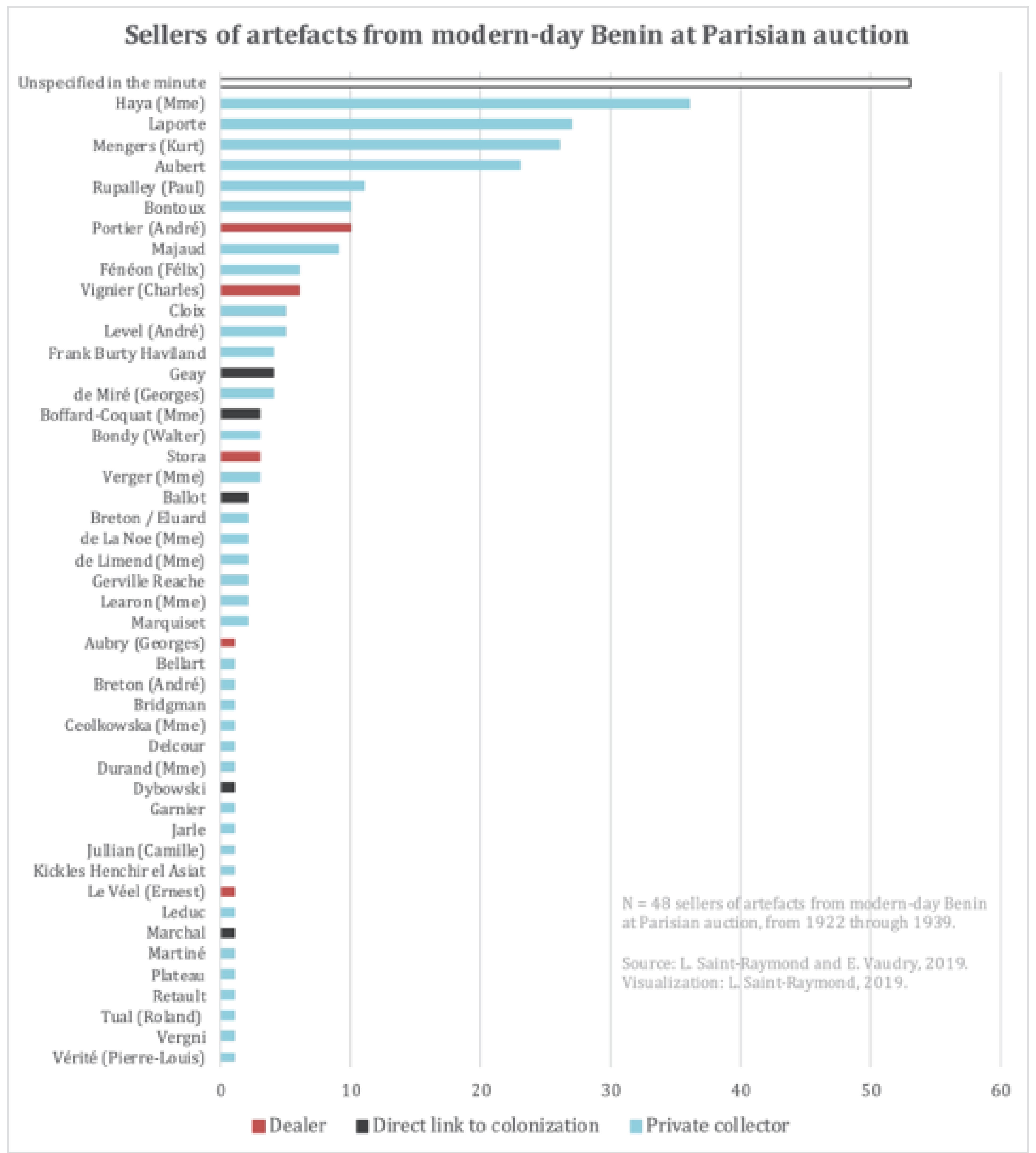
Fig. 6: Sellers of artefact from pre-colonial kingdom of Dahomey (modern-day Benin) at Parisian auction from 1922 through 1939.
So how did these artefacts arrive from Africa in the Parisian auction market? One can be reasonably certain that just about all the objects from Afrique Occidentale Française and Afrique Équatoriale Française present in France in this period came there in some form of colonial or missionary baggage. Historical evidence argues strongly against the possible presence of African traders bringing objects directly to the metropolis for sale, as almost no sub-Saharan Africans were resident in the city during these years.27 There is also no evidence indicating the existence of a network of suppliers and distributors analogous to the one constructed after decolonization by the “runners” who played such an important role in supplying the Western market. As a consequence, the only possible means by which these objects could have arrived in Paris was in the hands of colonial civil servants, missionaries, businesspeople, and soldiers returning from Africa.
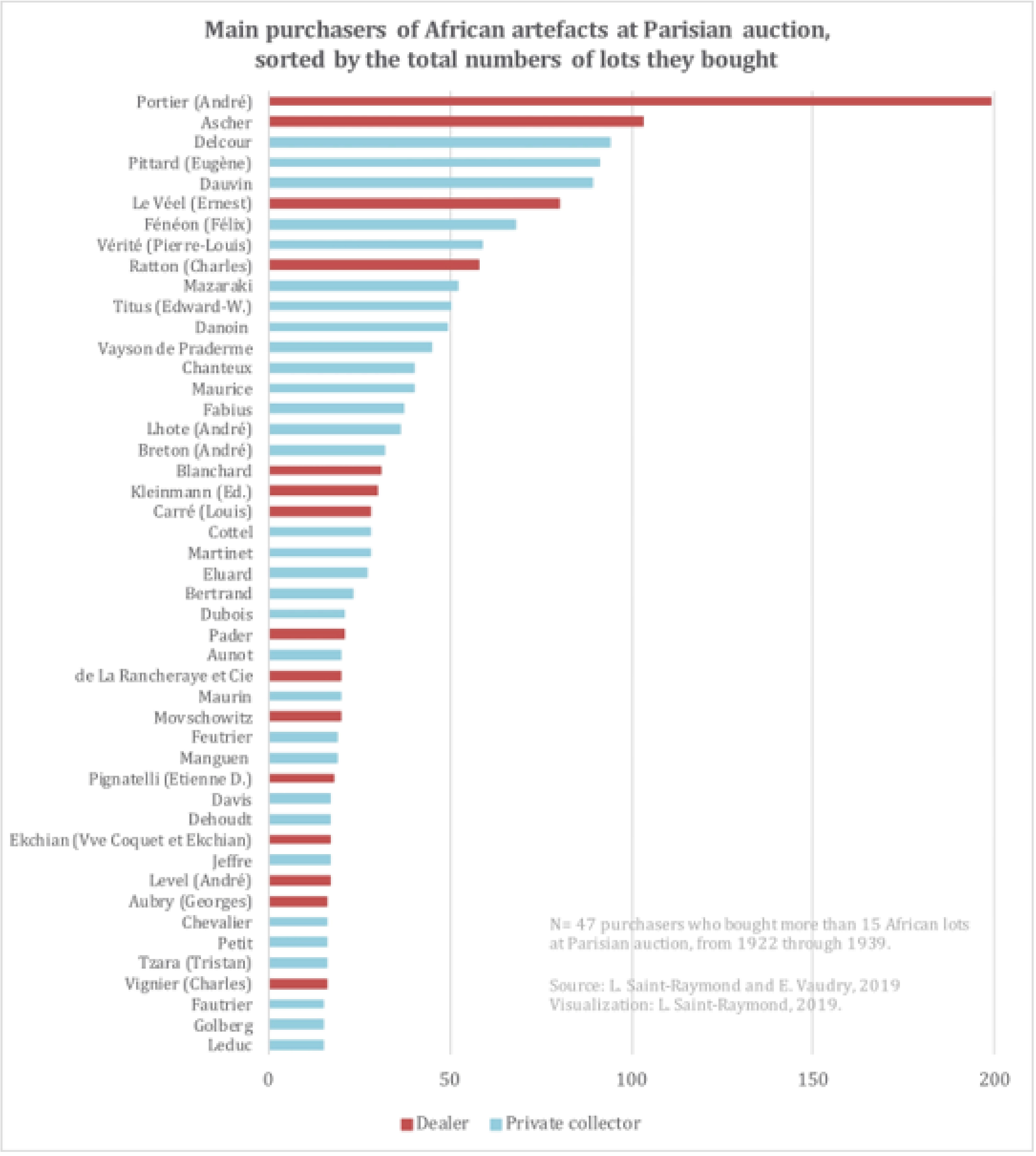
Fig. 7: Main purchasers of African artefacts at Parisian auction (1922-1939), sorted by the total number of lots they bought (excluding repurchases)
Why, then, do so few of these people seem to appear as sellers at Parisian auction? Three hypotheses can be presented. First, most of the “coloniaux” were and remain obscure, with names that may no longer be connected to specific biographies. Another hypothesis is that the world of auction sales may have had a relatively high cultural barrier to entry, and would therefore have been only actually accessible to those with some degree of awareness about buying and selling art and antiques. Ordinary merchant seamen, soldiers, and low-level civil servants would not necessarily have been in a position to acquire this kind of knowledge. They might also not necessarily have been aware that any African trophies or souvenirs obtained during their service could potentially be valuable.28 Indeed, the list of the main sellers (fig. 5) shows that the most important ones were quite familiar with the Parisian world of art and auctions – Félix Fénéon, Georges de Miré, André Level, Frank Burty Haviland, André Breton, Paul Éluard, along with the abovementioned Parisian dealers. There would have been a dual market – and this is our final hypothesis, explaining why the “coloniaux” were absent from the Parisian auction one. Indeed, the point where these African objects entered the market of the metropolis was often the “brocante” or “marché aux puces” rather than the Hôtel Drouot. In the case of Breton and Eluard, their correspondence shows that this is in fact how the two men built most their own collections of African artefacts.29 The Parisian art and antique auction was therefore a resale market.
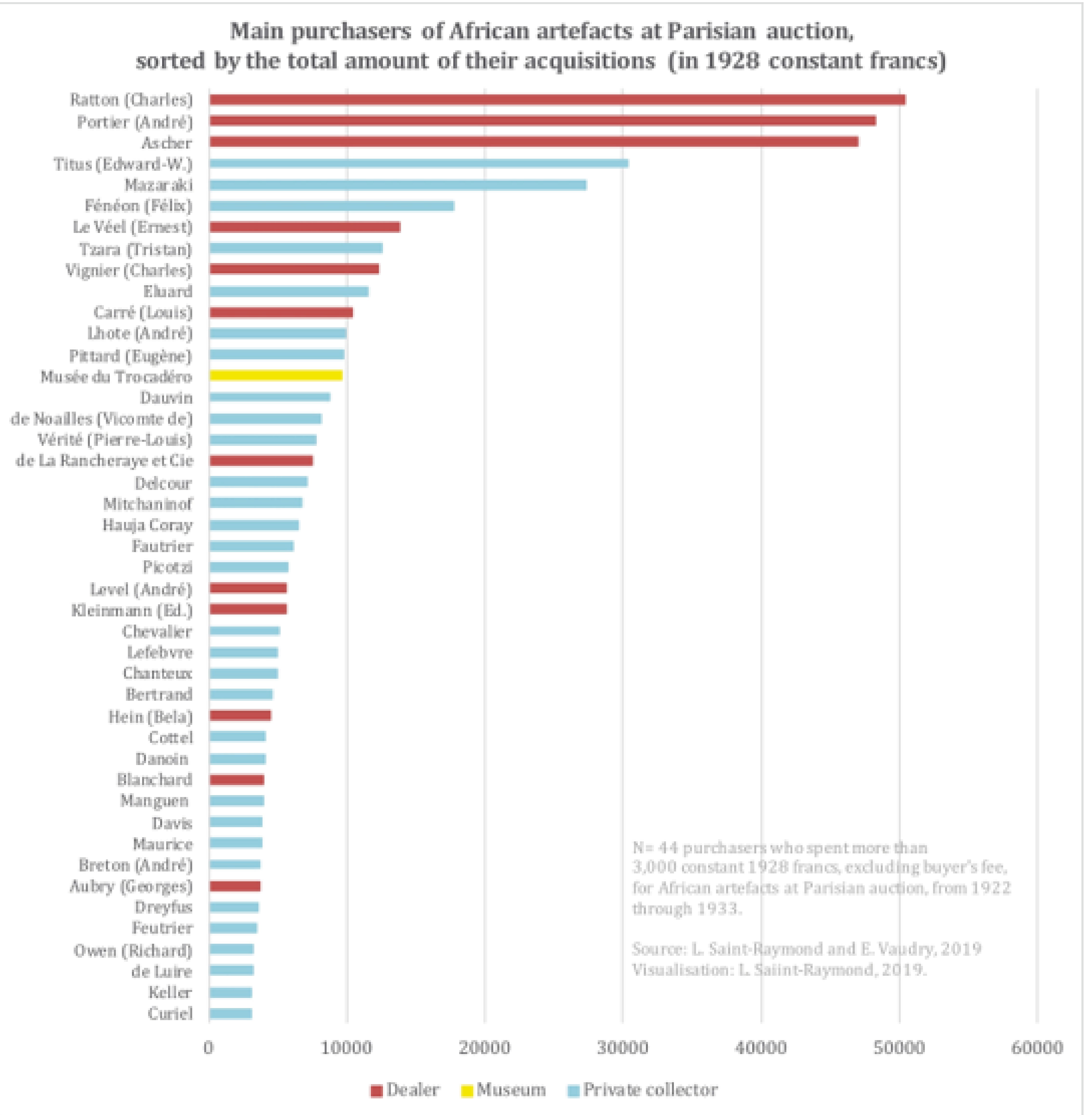
Fig. 8: Main purchasers of African artefacts at Parisian auction (1922-1939), sorted by the total amount they spent, in constant 1928 francs, excluding buyer’s fee and repurchases.
Being “expertisé” and offered at auction was not the beginning of an African sculpture’s journey from curio to “objet d’art” – it was an indication that journey was already underway. The path to the Hôtel Drouot moved these objects into the realm of anonymization, as the auction market stripped African objects of their history by blurring their provenance or geographical origin. In other words, the market glossed over the aspect of colonial seizures: auction catalogues made the identity of sellers anonymous and the elusive descriptions of the artefacts ignored the conditions of their appropriation, creating the illusion of a “doux commerce”. Not only did the violence of the appropriation remain untold but reconstituting the artefact’s history may become impossible: for instance, how might one identify an “African” object sold anonymously at auction, in reality by Mr. Laporte, or any other unidentified actor, such as Mrs. Haya or Mr. Cloix?
If the origin of the African objects before the sale is destined for oblivion, their destination can nevertheless be traced with slightly more precision and highlights several groups of buyers, who perceived and valued the objects in different ways.
By giving the name of the purchaser and, sometimes, his or her address, the auction minutes permit to draw up a typology of buyers of African artefacts. Our database counts 624 different purchasers, i.e. 4.5 times the number of sellers. Many of them were occasional bidders: 330 bought only one African lot (53% of the buyers) and 98, two lots (30%). Only 17% of successful bidders bought three or more African lots. The graph in fig. 7 lists the main buyers, by the number of lots they purchased, and the graph in fig. 8 ranks these according to the total amounts spent in constant 1928 francs. These two graphs exclude buybacks by sellers. These visualizations are a striking demonstration of the presence of dealers among the main buyers, marked here in red. The latter appeared much more often as buyers than sellers. André Portier was even the most important successful bidder in terms of volume of purchases – his position as expert for the sale of African objects and, more generally, for non-European objects, gave him a head start. In terms of amounts spent, Portier came second after Charles Ratton, another expert for these sales, who bought 58 African lots at auction in Paris for a total of 50,365 constant 1928 francs, or nearly 31,700 euros today. In addition, other Parisian antique dealers bought substantially: Ernest Ascher (1881–1930), Bela Hein (1883–1931), Ekchian from the house “Veuve Cocquet et Ekchian”, Louis Carré (1897–1977), Segredakis, Georges Aubry, Pader, Blanchard. The purchasers of these African artefacts also included a Parisian merchant of pearls and gemstones, Movschowitz, a few modern paintings dealers – Pierre Loeb (1897–1964), René Keller, André Level (1863–1947) who was the owner of the Galerie Percier, Adolphe Basler (1876–1951) – and two print dealers, Ernest Le Véel and Édouard Albert Kleinmann, who had been innovative at the beginning of the century in, for the former, purchasing Persian miniatures, and for the latter, sales of the Courrier français.30
Competing with these market professionals, another group appears: collectors who could be called “ethnographers”. From their point of view, the artefact is in never considered as an artwork but rather as a specimen, having the value of a record for the society that created it. This concept developed with the rise of ethnology or “social anthropology”31 at the end of the nineteenth century and accelerated with the creation of the Musée d’Ethnographie du Trocadéro in ١٨٧٨: in the scholarly division of labor, the museum thus played the role of a “museum-laboratory”, a place for storing data with view to confrontation and analysis. In May 1931, the “ethnographic” method of valuing objects was rationalized by the organizers of the Dakar-Djibouti mission, Marcel Griaule (1898–1956) and Michel Leiris (1901–1990):
A collection of ethnographic objects is neither a collection of curiosities nor a collection of artworks. The object is nothing more than a witness, who must be considered on the basis of the information he or she provides about a given civilization, not on its aesthetic value. It is therefore necessary to get used to collecting all kinds of objects and to get rid of two prejudices in the first place, that of purity of style and that of rarity.32
However, this conception of objects was not limited to members of ethnographic expeditions. It was also found in the auction market. The Swiss anthropologist and prehistorian Eugène Pittard (1867–1962) was the fourth-biggest auction purchaser by volume of African acquisitions (fig. 7). Pittard created the Museum of Ethnography in Geneva in 1901 and the Swiss Institute of Anthropology in 1912.33 Another important bidder was the prehistorian André Vayson de Pradenne (1888–1939), who became a professor at the School of Anthropology in 193234 and who was also a major player in the auction market for prehistoric artefacts during the same period.35
Among the “ethnographer” buyers, two museums appeared in the minutes, the “musée de Munich”, most probably the Museum für Völkerkunde, which bought a polychrome wooden mask from Côte d’Ivoire on 7 May 1931 at the price of 923 constant 1928 francs, and the Musée d’Ethnographie du Trocadéro, which bought an elephant tusk “taken from a sacrificial shrine at Benin, West Africa, by Captain Ch. Ringer, East Lancs Regt. Feby 1898 », for 9,603 constant 1928 francs at Walter Bondy’s sale (fig. 9). This elephant tusk was the only African acquisition of the Musée d’Ethnographie du Trocadéro in the interwar period: ethnographic and scientific missions were therefore a much more important way of enriching the collections than Parisian auctions. This acquisition took place very “late”, in June 1932: French museums and art collectors in fact did not take a particularly active interest in objects from the Kingdom of Benin (Nigeria) until the early 1930s when the dealers Charles Ratton and Louis Carré, working in tandem with the curator Georges Henri Rivière, began a campaign to promote Benin art – the Trocadéro purchase of the ivory tusk might have been made in response to this campaign.36
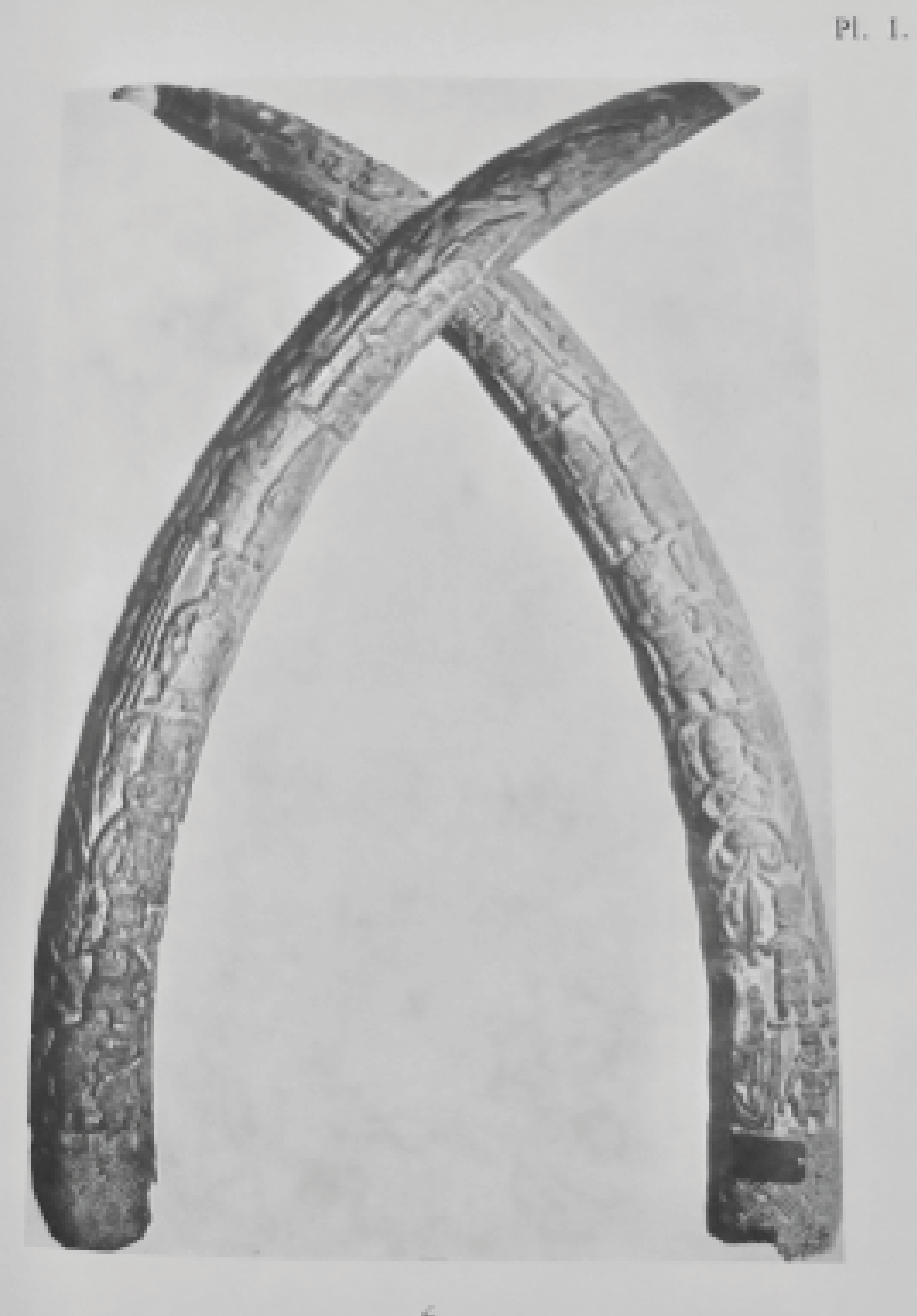
Fig. 9: Elephant tusk entirely carved in bas-relief, with, on the base, a copper plate inscribed "taken from a sacrificial shrine at Benin, West Africa, by Captain Ch. Ringer, East Lancs Regt. Feby 1898", h: 162 cm [22 June 1932, auction sale lot 6]. It is now in the collection at the Musée du Quai Branly Jacques Chirac (PP0115242).
The two graphs of the main buyers show a final group composed of “active promoters” of African objects who valued them more as artworks than as ethnographic specimens. These purchasers were indeed important lenders of African artefacts for the founding exhibitions of the interwar period37 (fig. 10): the exhibition of “Negro and Oceanian art” organized by Paul Guillaume at the Galerie Devambez between 10 and 31 May 1919, in which Henri Clouzot and André Level also played an important role,38 “L’art nègre” at the Brussels Palais des Beaux-Arts, from 15 November to 31 December 1930,39 the exhibition of African and Oceanic art at the Théâtre Pigalle in 1930, 40 and “African Negro Art” in 1935 at the Museum of Modern Art in New York (MoMA).41
Among these “active promoters”, the comparison between graphs fig. 7, 8 and 10 shows market participants close to the artistic scene, first and foremost Paul Guillaume, Charles Ratton and Tristan Tzara. Through their loans, many artists supplied the exhibitions, notably the avant-garde painters Maurice de Vlaminck (1876–1958), André Derain (1880–1954), André Lhote (1885–1962) and Georges de Miré (1890–1965).42 Some Surrealists also took an active part in these exchanges, particularly Tristan Tzara and Roland Tual (1902–1956) or the dealer Charles Ratton, then friend and promoter of this movement43 – while André Breton and Paul Éluard purchased and sold more than they lent. The group of promoters-purchasers of African artefacts also included prominent dealers such as Louis Carré, Bela Hein, Ernest Le Véel, Pierre Loeb, Jos Hessel, Raphaël Stora, Paul Guillaume and André Level for Galerie Percier, but also the art critics Christian Zervos (1889–1970) and Paul Chadourne (1898–1981), who published several articles promoting African art. The former created the Cahiers d’art magazine in 1926, which regularly published texts on African arts44 and the latter wrote several articles on the subject, notably in Le Point: revue artistique et littéraire in 1937.45 To these two personalities must be added that of the critic and collector Félix Fénéon (1861–1944) who exhibited his African works on several occasions, especially at the Pigalle Gallery in 1930 and at MoMA in 1935 (fig. 10). His case is all the more interesting as the curator of the “African Negro Art” exhibition, James Johnson Sweeney, traveled to Paris in 1935 to see Fénéon’s personal collection and chose the pieces he wished to exhibit a few months later in the museum then directed by Alfred H. Barr Jr.46 Finally, the group of active promoters, who also bought substantially at auction, included private collectors such as Helena Rubinstein (1872–1965) and the doctor and specialist in African art, Charles-Stephen Chauvet (1885–1950).47
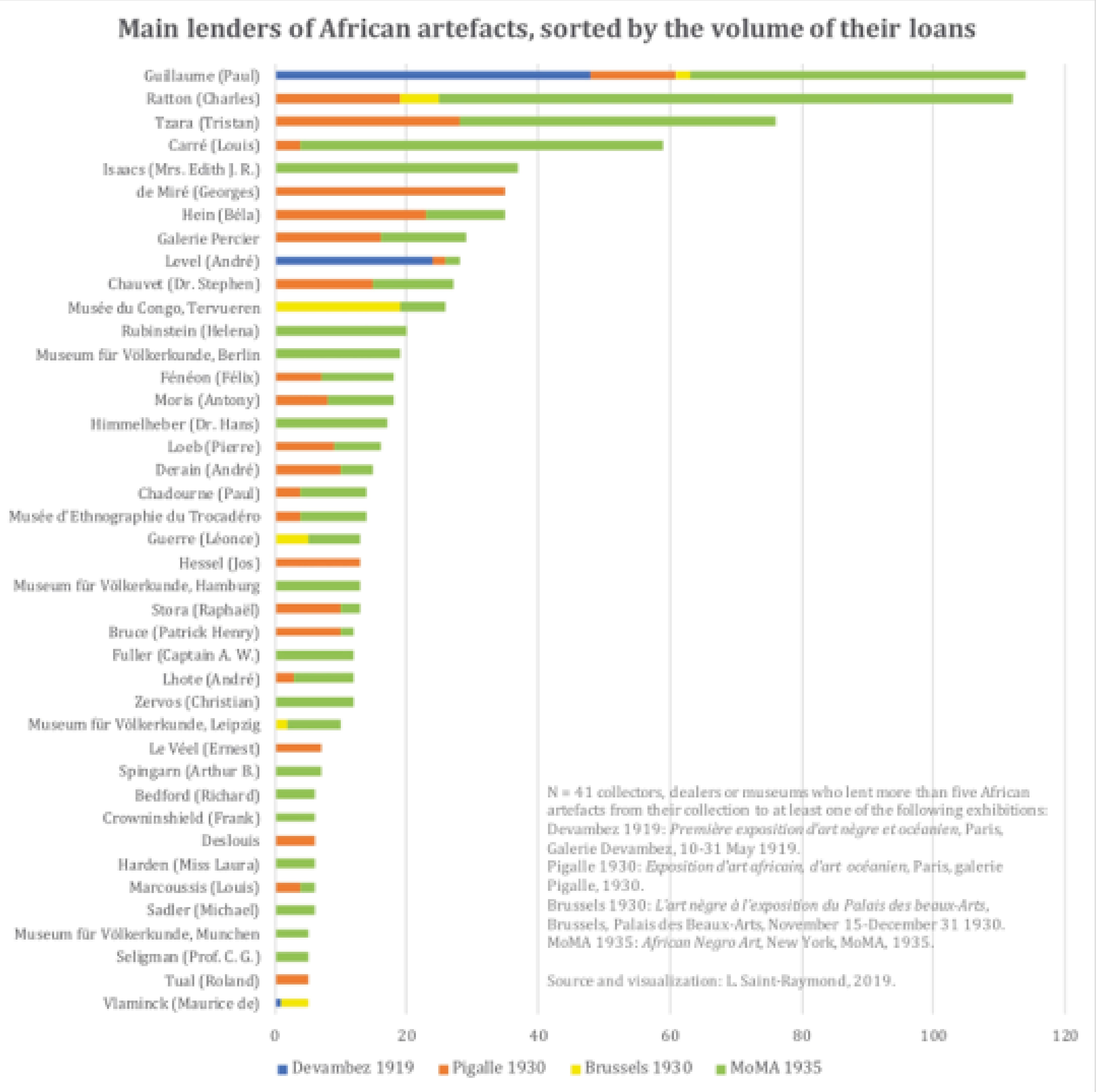
Fig. 10. Main lenders of African artefacts, sorted by the volume of their loans
Some of these promoter-purchasers were also very active in selling African artefacts, for instance Félix Fénéon, André Level, Charles-Stephen Chauvet, Georges de Miré, and Paul Guillaume. Acting as suppliers, the display of their collections in renowned galleries or international museums added commercial and artistic value to the works. A case in point is Félix Fénéon: when he lent some pieces of his collection to MoMA in 1935, he set the insurance value at up to forty times the market price.48 Conversely, loans to exhibitions would increase the potential hammer price of the African artefacts at auction.
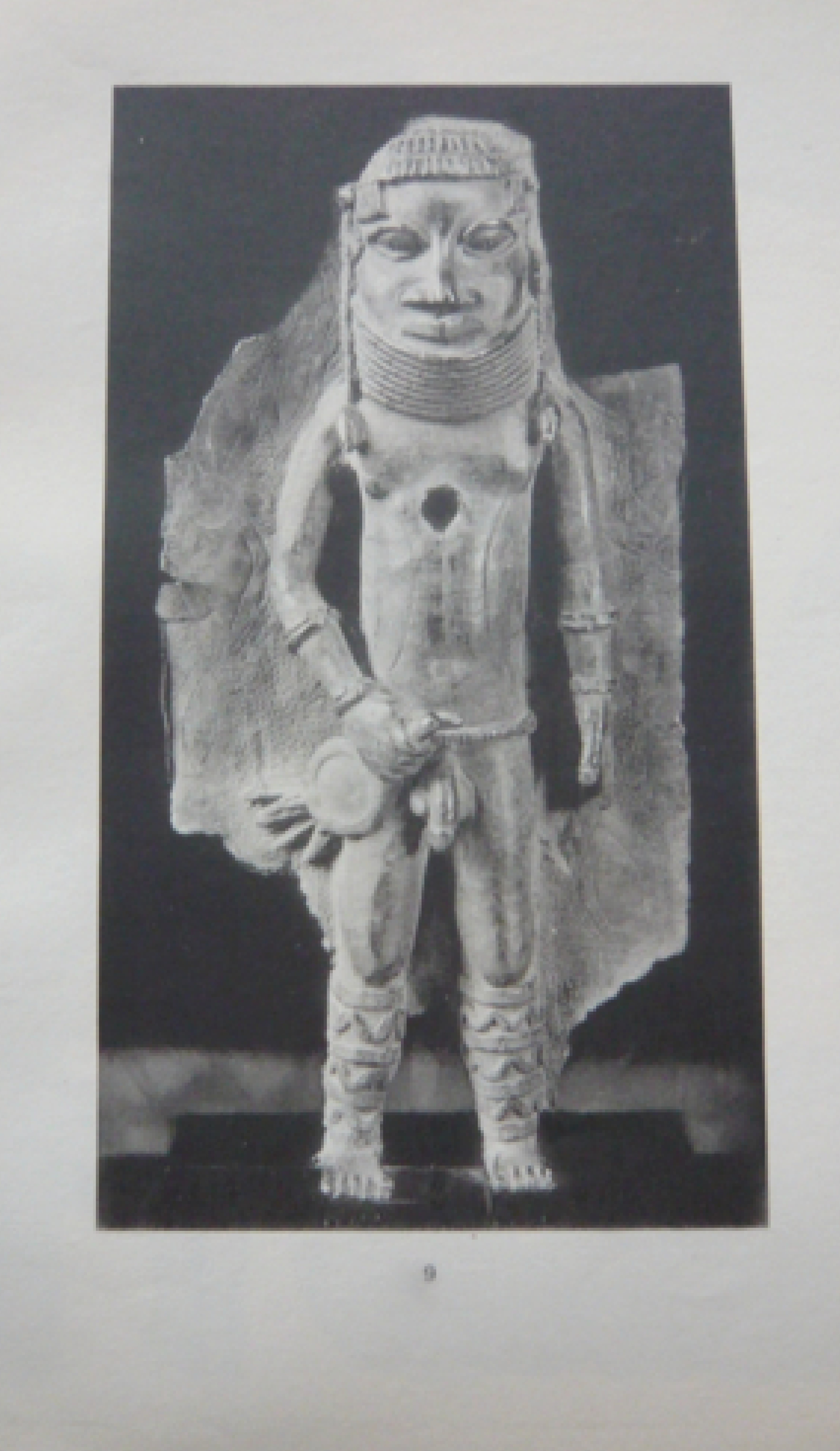
Fig. 11. “Cover plate. It depicts, in high relief, a male child statue, naked, whose hairstyle falls into two braids on his shoulders. He wears a large necklace, bracelets and leggings and holds a fan. Bronze”, Benin, 16th-17th centuries, h. 37 cm, reproduced in Collection André Breton et Paul Éluard. Sculptures d'Afrique d'Amérique d'Océanie, [July 2-3 1931 auction sale lot 9], pl. I.
The database of the Parisian auction market for African artefacts allows to understand their commercial, artistic and scientific valuation processes by tracing their visual and semantic paths. Two main techniques contributed to increase the value of African objects: adding photographic reproductions to auction catalogues and mentioning a bibliographical reference.49
The reproduction of African objects provided them with a guarantee of authenticity and an aesthetic aura.50 For instance, in the Breton-Eluard auction sale of July 1931, nine African objects were reproduced in the catalogue, reaching an average hammer price of 3,285 constant 1928 francs, while the remaining twenty-one which did not benefit from any photography were sold for an average of 241 constant 1928 francs, almost 14 times less. Among the nine African objects reproduced in this catalogue, only one benefited from a full-page photograph, isolated on a single plate: a bronze from Benin, in present-day Nigeria, representing a statuette of a child (fig. 11). The composition of the photograph transmuted the African artefact into a true avant-garde sculpture: the zenithal light illuminates the object, the black background is brilliant and the absence of decoration gives a timeless aesthetic weightlessness. The auction catalogue thus endowed the Benin bronze with new artistic value which in turn increased its hammer price: 6,804 constant 1928 francs, paid by Charles Ratton.
While twenty-four sellers adopted the strategy of reproducing the artefacts, only three people gave bibliographical references for some of the items they put up for sale: the collector Paul Rupalley, the cubist painter Frank Burty Haviland (1886–1971) and the draftsman and photographer Walter Bondy (1880–1940). The auction catalogue of Rupalley’s collection in March 1930 mentions a bibliography for six African artefacts, which were reproduced in three journals – Le Bulletin de la vie artistique,51 L’Art vivant52 and Le Progrès médical53 – and in André Level’s and Henri Clouzot’s book, Sculptures africaines et océaniennes. Colonies françaises et Congo Belge.54 Walter Bondy had his artefacts reproduced twice in Die Altertümer von Benin published in 1919 by the Austrian anthropologist Felix von Luschan (1854–1924)55 while twelve artefacts from Haviland’s auction sale had a bibliography, featured in Carl Einstein’s Negerplastik56 and Marius de Zayas’s African Negro Art. Its Influence on Modern Art.57
Some references would increase the “scientific” value of the African artefacts, by certifying their relevance and their authenticity, in particular the medical journal Le Progrès medical, in which Stephen Chauvet wrote, and Felix Von Luschan’s Die Altertümer von Benin. Interestingly, the latter served as a reference and as a scientific guarantee. For instance, when George de Miré sold his collection on 16 December 1931, he referred to Von Luschan’s publication for the description of lot 39, even if the item was not directly included in the book: “Von Luschan reports six necklaces or fragments of similar necklaces: one at the British Museum, two at the Pitt Rivers Museum in Farnham, two at the Ethnography Museums of Hamburg and Leipzig and one formerly in the Egerton collection, which could well be this one”.58
From a journal to an auction catalogue, the description of a same African artefact could undergo a semantic change. For instance, a wooden mask from Paul Rupalley’s collection was reproduced in “Enquête sur des arts lointains”, written by Félix Fénéon in the Bulletin de la vie artistique of 15 November 1920, as an illustration for the interview of Salomon de Reinach, member of the Institut and curator of the Musée des Antiquités nationales in Saint-Germain-en-Laye.59 Its caption was laconic – “Rivières du Sud. Dancer’s mask (wood. 30 cent. without hair). Coll. P. Rupalley” (fig. 12). Ten years lated, when the mask was sold at auction on 17 March 1930 – Tristan Tzara bought it – the description changed: “a carved wooden mask with a black patina and a fibre beard and hair. Simian face, adorned with natural teeth. Rivers of the South. High: 320 mill.”60 This second notice removed the reference to dance and emphasized the materials and their anthropomorphic and even human nature “beard, hair, teeth”. The use of the term “simian” also referred to the monkey, which may be an allusion to social Darwinism and its specific amalgam at the time between primates and African populations.
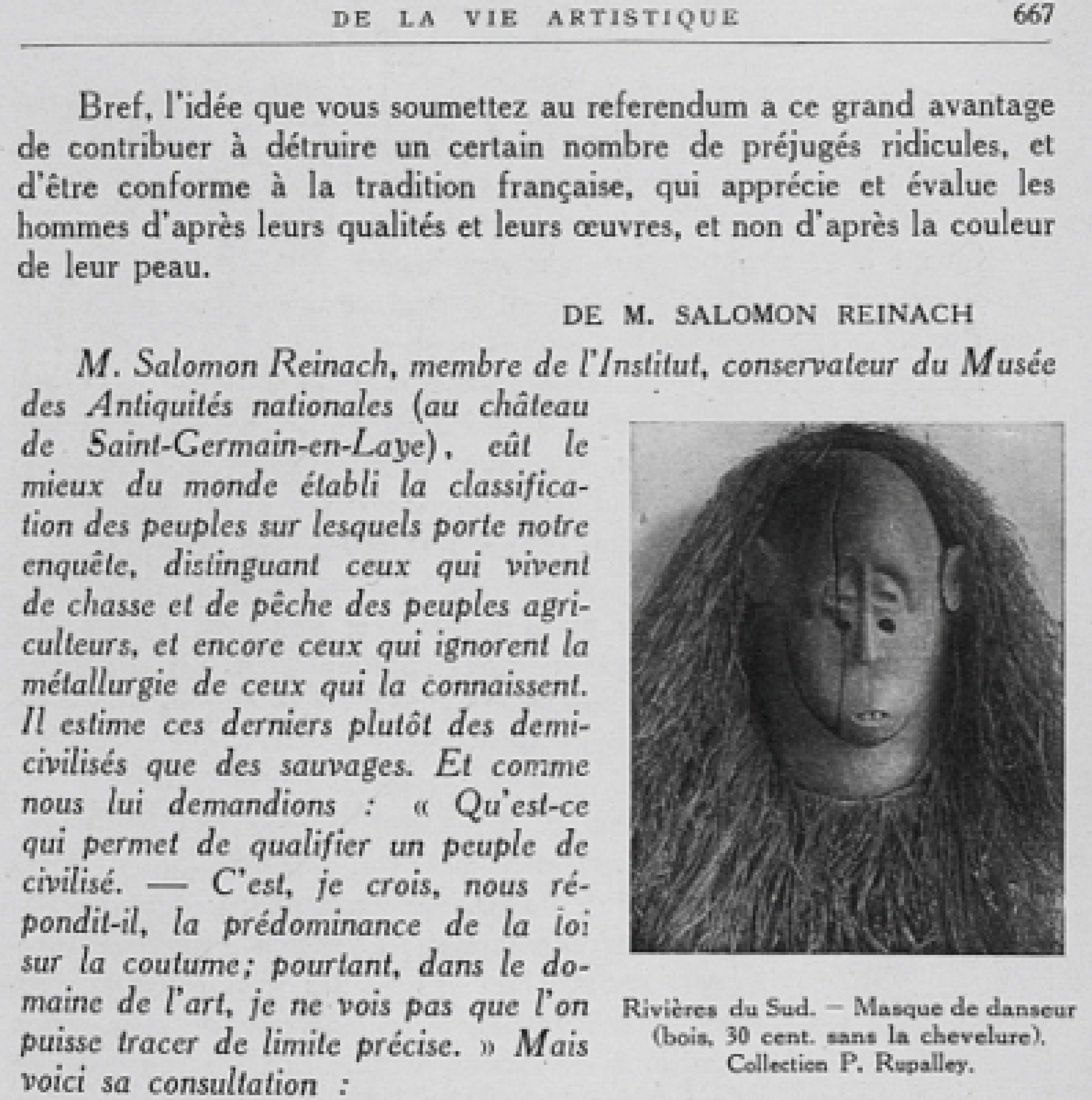
Fig. 12. Mask, made of carved wood, black patina, with beard and fibre hair. Simic face, adorned with natural teeth, Southern Rivers, Africa, h: 32 cm [March 17-18, 1930, auction sale lot 135] reproduced in Félix Fénéon, " Enquête sur des arts lointains. Seront-ils admis au Louvre ? ", Le bulletin de la vie artistique, n°24, 15/11 (1920), 667.
If the majority of African objects, sold at Parisian auction, disappeared in anonymity and obscurity – silence about their violent appropriation, anonymity of the sellers, failure to identify their buyer – some were, on the contrary, widely enhanced and documented by a small group of “promoter” collectors and dealers, who appeared simultaneously in auction sales as sellers and purchasers, in exhibitions as lenders, and in publications as writers or owners of the artefacts. This small group connected geographical areas together and happened to be the main protagonists in the pre-Columbian and Oceanian arts market in the interwar period.
Anonymity, be it that of the seller, the artefact or its colonial appropriation, thus contributed to building a history of French taste. The apparatus of the African art market allows us to identify preferences for the production of the French colonies and the favourable position of Abomey’s creations among scholars and artists. The French colonial identity of the 1920s and 1930s did not assert itself directly in the art market, but it shaped the taste of collectors. This construction of the gaze is established in direct correlation with exhibitions and publications; the African art market cannot award prizes without justifying their value by national and international, scholarly and artistic references or by discursive and aesthetic strategies. In short, the African artefact is presented as a vector, diachronic, transcultural and transcontextual, or even an actor in French colonial discourse.
Léa Saint-Raymond is a post-doctoral fellow at the École normale superieure. Élodie Vaudry is a post-doctoral fellow at the Universidad Nacional Autónoma de Mexico.
1 The authors would like to thank John Warne Monroe for an exciting and thorough review of their paper. Manuel Charpy, L’objet et ses horizons: la fabrique des objets exotiques à Paris et New York au xixe siècle, in Material Culture Review / Revue de la culture matérielle, 79, spring 2014, 24-45.
2 Yaëlle Biro, African arts between curios, antiquities, and avant-garde at the Maison Brummer, Paris (1908-1914), in Journal of Art Historiography 12, 2015: 1-15; Yaëlle Biro, Fabriquer le regard – Marchands, réseaux et objets d’art africains à l’aube du XXe siècle, (Paris: Les presses du réel, 2018).
3 Philippe Dagen and Maureen Murphy, eds., Charles Ratton, l’invention des arts “primitifs”, exh. cat., Paris, Musée du Quai Branly, 25 June to 22September 2013, (Paris: Skira, 2013).
4 Léa Saint-Raymond, Le pari des enchères: le lancement de nouveaux marchés artistiques à Paris (1830-1939), (Paris: Classiques Garnier, forthcoming).
5 Christine Howald and Léa Saint-Raymond, Tracing Dispersal: Auction Sales from the Yuanmingyuan Loot in Paris in the 1860s, in Journal for Art Market Studies, vol. 2, no. 2, (2018) DOI 10.23690/jams.v2i2.30,accessed 4 October 2019.
6 Léa Saint-Raymond and Élodie Vaudry, A New Eldorado: The French Market for Pre-Columbian Artefacts in the Interwar Period, in Charlotte Guichard, Christine Howald and Bénédicte Savoy, eds, Acquiring Cultures. Histories of World Art on Western Markets (Berlin: De Gruyter, 2018), 101-119.
7 Yaëlle Biro, Fabriquer le regard – Marchands, réseaux et objets d’art africains à l’aube du xxe siècle; John Warne Monroe, Metropolitan Fetish. African Sculpture and the Imperial French Invention of Primitive Art (Ithaca: Cornell University Press, 2019).
8 All the Parisian auction sales whose catalogues include “African”, “pre-Columbian”, “Oceanian”, “nègre” or “primitive” artefacts were considered. The list of these auction sales is available online: Léa Saint-Raymond and Élodie Vaudry, Félix Fénéon and the Parisian auction market for African, Oceanian and pre-Columbian artefacts, in the interwar period, Harvard Dataverse, 2019, https://dataverse.harvard.edu/dataset.xhtml?persistentId=doi:10.7910/DVN/P5H5ET.
9 Yaëlle Biro, Avant Charles Ratton. Commerce et diffusion des arts africains des années 1900 aux années 1920, in Charles Ratton, l’invention des arts “primitifs”, 42-57.
10 The first sale of escrow, for the Kahnweiler collection [Lugt 82348] had included a lot, no. 150, described as follows: “Negro art. 7 carved wooden objects: fetishes, masks and various utensils. This lot will be sold per unit.” As the minutes are not available, the purchasers are unknown. However, this marketing was not a voluntary process, unlike in Paul Guillaume’s case.
11 Regarding this exhibition, see Benoît de l’Estoile, Le goût des Autres. De l’Exposition coloniale aux Arts premiers (Paris: Flammarion, 2010 [2007]), 68. Bellier’s annotated auction catalogue, kept in the Paris archives, confirm that “Paul”[Guillaume] was the only seller for these “negro sculptures”.
12 Vérane Tasseau, Les Ventes de séquestre à la galerie Kahnweiler et leur réseau d’acheteurs: l’exemple d’André Breton et Paul Éluard, OJO, Journal de Picasso administration, November 2016, https://www.picasso.fr/ojo-le-journal, accessed 4 October 2019.
13 Léa Saint-Raymond and Élodie Vaudry, A New Eldorado: The French Market for Pre-Columbian Artefacts in the Interwar Period, 104-108.
14 Léa Saint-Raymond, La création sémantique de la valeur. Les ventes aux enchères d’objets chinois à Paris (1858-1939), in Michel Espagne and Li Hongtu eds., Chine France - Europe Asie. Itinéraires de concepts, (Paris: Éditions Rue d’Ulm, 2018), 217-239.
15 Léa Saint-Raymond, Produit de la bourse commune des commissaires-priseurs parisiens entre 1831 et 1936, Harvard Dataverse, 2018, https://dataverse.harvard.edu/dataset.xhtml?persistentId=doi:10.7910/DVN/9GDV2J accessed 4 October 2019.
16 INSEE, converter franc-euro, https://www.insee.fr/fr/information/2417794, accessed 4 October 2019.
17 «Cette pièce et les suivantes ont été trouvées, enfouies dans la terre au palais de Béhanzin, lors de la prise d’Abomey par les colonnes françaises en janvier 1894». Auction catalogue, 22 March 1939, lot 1.
18 Auction catalogue, 22 March 1939, lot 6.
19 See John Warne Monroe, Metropolitan Fetish. African Sculpture and the Imperial French Invention of Primitive Art, chapter 5.
20 For more on the war’s media significance and place in the French colonial imaginary, see See John Warne Monroe, Metropolitan Fetish. African Sculpture and the Imperial French Invention of Primitive Art, chapter 5 and Suzanne Preston Blier, African Vodun: Art, Psychology, and Power (Chicago: University of Chicago Press, 1995).
21 The only information concerning Laporte is “Grand Propriétaire, Château Neuf, Créon” (Annuaire de la Gironde et des départements circonvoisins, 76e année, 1927, Bordeaux: Gounouilhou, 1927). At the Gironde departmental archives, the census does not provide any more information (6 M 166).
22 http://www.military-photos.com/histo11chass.htm, accessed on 11 July 2018.
23 See the advertising insert in Nice & the world historical attractions, English and French, Paris: D. S. Batti, 1920, 14.
24 Numa Broc, Dictionnaire des Explorateurs français du XIXe siècle, Afrique (Paris: CTHS, 1988), 128-130.
25 List of the colonial administrators in Dahomey, Archives nationales d’outre-mer, http://anom.archivesnationales.culture.gouv.fr/ark:/61561/wz818xswrty, accessed 4 October 2019.
27 See Jennifer Anne Boittin, Colonial Metropolis: The Urban Grounds of Anti-Imperialism and Feminism in Interwar Paris (Lincoln: University of Nebraska Press, 2010).
28 As Monroe shows, throughout the first half of the 1920s, colonial journalists and other commentators uniformly dismissed the aesthetic value of African wood sculptures. See John Warne Monroe, Metropolitan Fetish. African Sculpture and the Imperial French Invention of Primitive Art, chapter 6.
29 See John Warne Monroe, Metropolitan Fetish, chapter 5.
30 Léa Saint-Raymond, Le pari des enchères: le lancement de nouveaux marchés artistiques à Paris (1830-1939).
31 Florence Weber, Brève histoire de l’anthropologie (Paris: Flammarion, 2015), 12-13.
32 Instructions sommaires pour les collecteurs d’objets ethnographiques (Paris: Musée d’ethnographie, May 1931), 8.
33 Marguerite Lobsiger-Dellenbach and Georges Lobsiger-Dellenbach, Eugène Pittard 1867–1962, in Le Globe (revue genevoise de géographie), tome 102, 1962, 22-25.
34 “Nécrologie”, in Bulletin de la Société préhistorique française, t. XXXVI, no.12, 1939, 478-479.
35 Léa Saint-Raymond, Entre spécimen et “belle série”: la paradoxale mise en art des objets préhistoriques en vente publique (1882-1933), in Revue de l’Art, 2019, forthcoming.
36 For more information, see John Warne Monroe, Metropolitan Fetish. African Sculpture and the Imperial French Invention of Primitive Art, chapter 5, and Annie E. Coombes, Reinventing Africa – Museums, Material Culture & Popular Imagination in Late Victorian & Edwardian England (New Haven: Yale University Press, 1997).
37 The exhibition of the “art indigène des colonies françaises d’Afrique et d’Océanie et du Congo Belge”, at the Musée des arts décoratifs, Pavillon de Marsan, in 1923, couldn’t be included in the graph, as there is no available exhibition catalogue. For more information, see Henri Clouzot and André Level, L’art indigène des colonies françaises et du Congo belge au Pavillon de Marsan en 1923, in L’Amour de l’Art, no.1, 1924, 17-22.
38 Henri Clouzot, Première exposition d’art nègre et océanien, exh. cat., Paris, Galerie Devambez, 10-31 May 1919, (Paris: s. n., 1919). See John Warne Monroe, Metropolitan Fetish. African Sculpture and the Imperial French Invention of Primitive Art, chapters 2 and 3.
39 Joseph Maes, Henri Alfred Lavachery, L’art nègre à l’exposition du Palais des beaux-arts, exh. cat., Brussels, Palais des beaux-arts, 15 November to 31 December 1930, (Bruxelles-Paris: Librairie nationale d’art et d’histoire, 1930).
40 Galerie Pigalle, Exposition d’art africain, d’art océanien, exh. cat., Paris, Théâtre Pigalle, 1930 (Paris: Galerie Pigalle, 1930).
41 James Johnson Sweeney, African Negro Art, exh. cat., New York, Museum of Modern Art, 1935, (New York: Museum of Modern Art, 1935).
42 Georges de Miré was the cousin of the Cubist painter Roger de La Fresnaye (1885-1925), himself a photographer and a collector of African art who had bought “Negro woods” in 1913 and lent his objects to the exhibition “L’Art indigène des colonies françaises et du Congo belge” in 1923 at the Marsan pavilion.
43 Philippe Dagen, Vie de Charles Ratton, 15.
44 For example: Charles Ratton, Collection G. de Miré. Sculptures from Africa and America, in Cahiers d’art, no.6, 1931, 453-454.
45 Paul Chadourne, Le dernier portrait de Roger de La Fresnaye, in Le Point: revue artistique et littéraire, July, 1937, 91-92.
46 Yaëlle Biro, Léa Saint-Raymond and Élodie Vaudry, African Negro Art at MoMA, 1935: Félix Fénéon’s African Art Collection in Context, in Félix Fénéon (New York: MoMA, 2019).
47 Chauvet’s interest in this material was primarily ethnographic, rather than aesthetic. He was very sympathetic to France’s colonial “mission,” and not particularly interested in associating “primitive art” with the artistic avant-garde. See John Warne Monroe, Metropolitan Fetish. African Sculpture and the Imperial French Invention of Primitive Art, chapter 2.
48 Idem.
49 For the econometric evidence, see Léa Saint-Raymond, Le pari des enchères: le lancement de nouveaux marchés artistiques à Paris (1830-1939).
50 Léa Saint-Raymond, L’aura démultipliée: la photographie comme vecteur de diffusion et de valorisation de la sculpture (1890-1930), in Sculptures, 6 (2019), forthcoming.
51 Félix Fénéon, Enquête sur des arts lointains. Seront-ils admis au Louvre ?, in Le bulletin de la vie artistique, no.24, 15/11 (1920), 667.
52 André Level, Henri Clouzot, Caractéristiques de l’art des noirs, in L’Art vivant, no.5, 1925, 11.
53 Stephen Chauvet, Les arts indigènes des Colonies françaises, in Le Progrès médical, no.7, 1924, 52.
54 André Level, Henri Clouzot, Sculptures africaines et océaniennes. Colonies françaises et Congo Belge (Paris: Librarie de France, 1925).
55 Felix von Luschan, Die Altertümer von Benin, Berlin, Leipzig: Vereinigung wissenschaftlicher Verleger, 1919, 121 and 462.
56 Carl Einstein, Negerplastik (Leipzig: Verlag der Weissen Bücher, 1915).
57 Marius de Zayas, African Negro Art. Its Influence on Modern Art (New York: Modern Gallery, 1916).
58 Collection G. de Miré. Sculptures anciennes d’Afrique et d’Amérique, auction sale, (Paris: Hôtel Drouot, 16/12, 1930), 6.
59 Félix Fénéon, Enquête sur des arts lointains. Seront-ils admis au Louvre?, 667.
60 Collection Paul Rupalley. Arts primitifs. Océanie, Afrique, Amérique et Asie, 16.